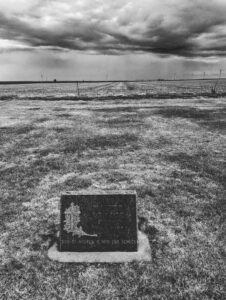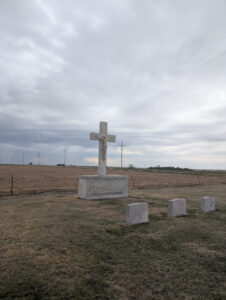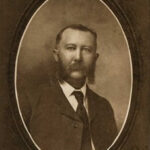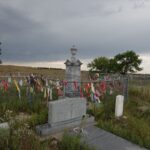Vindicated By a Confession
 We were crossing Kansas and I was struck by the title. It was one of those caches I felt compelled to visit.
We were crossing Kansas and I was struck by the title. It was one of those caches I felt compelled to visit.
I knew that people had believed that Walter Scheck killed a young woman in Colorado, on December 11, 1938, before killing himself. When we went to the cache we found a single solitary grave, separated from the others. Walter was not deemed worthy to be next to anyone. While we stood next to it, a storm gathered across the plain. It seemed appropriate.
Even after logging the cache I continued to wonder how Walter ended up here and how he was vindicated.
Walter had been a trusted member of the community. The local newspaper often reported that he had attended various private dinners or social events. On the evening of the crime,he went to a dance with June Veal and a friend. June and Walter died after being shot.
Dennis Carruthers came forward and maintained that he had been with them, although his brother Dale was the same age as June and more likely to go to the dance. He said that Walter killed June and then shot himself. The police found a handwritten note, allegedly written by Walter, naming people who could not be identified. Dennis’s story was accepted without question. No coroner’s inquest was held. 
In 1985, Walter’s family learned that Dale confessed to the crime on his deathbed. Dennis passed in 2009, taking what he knew with him.
In the end, we encounter the limitations of the justice system. It cannot ask the right questions or provide the necessary answers if guilt is simply assumed. It may be easier to move on after making a hurried judgment, but there are consequences that stretch beyond the moment. There are costs to fairness, to truth, and to the relationships we rely on to hold our communities together. All these things were at stake and made real as we stood by a lonely grave.
My Log:
I was a state public defender in California before I retired. We handled death penalty appeals. It is a long slow process. There were some clients who were classic sociopaths, others just had a bad week. Still, I had clients who I believe are not guilty — or not guilty of a capital crime. Defending the innocent is the hardest part of the job. The story here intrigued me and I am very much aware that Walter never had the chance to have a defense, with so much of the story lost in time.
Walter had a large family, but it still would not be easy to stand up for him in the face of the accusations. There would be no presumption of innocence. The local newspapers were clear that there was a witness to the killing and a suicide note was found in Walter’s clothing. No inquest was held.
The witness maintained that he took the young woman to a dance at Walter’s request. The two argued, and agreed not to see each other again. Then they were shot. The alleged note had messages to certain people but they were never identified. It made me wonder how Walter had time to shoot the victim and then write a note to two unknown people while the witness waited.
But who would not assume his guilt? The news articles took it for granted.
In many ways Walter’s story is a reminder of the importance of that presumption and how easy it is to wrongfully convict someone in the minds of a community. Today, social media can build a story, a rush to judgment. Even in Walter’s day, the dynamics of a small town (Wray Colorado) undoubtedly operated on a similar basis, especially when her father was a county commissioner.
In any event it must have taken courage to express belief in his innocence.
Most people facing trial will not have a Perry Mason moment whether the killer admits the crime. My guess is that the guilty person was a friend of both the victims. Of course he knew that Walter was not being imprisoned or facing legal judgment. He undoubtedly thought there was no need to come forth. But silence can impose its own burdens. Over the course of a lifetime it might weigh ever harder. I wondered how the silence affected him.
The confessor died in 1985. His brother, who had accused Walter, eventually passed in 2009 and had a number of children and grandchildren. A note on findagrave stated “We know. Rest in peace. Walter and June.” June is the name of the victim. There are those who know.
When we visited, the storm clouds were growing — lightning was on its way. It seemed a fitting time to be at the grave.


